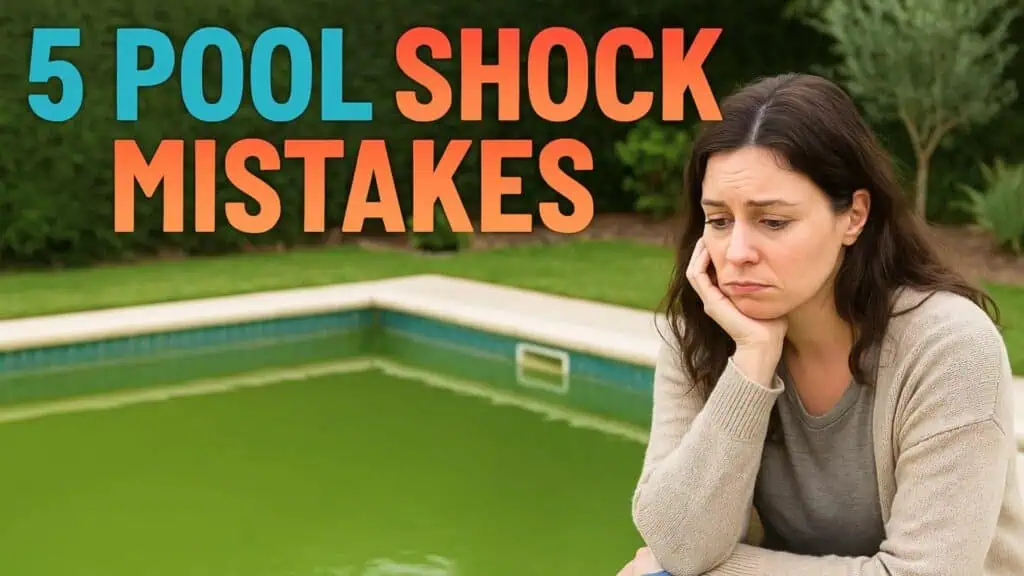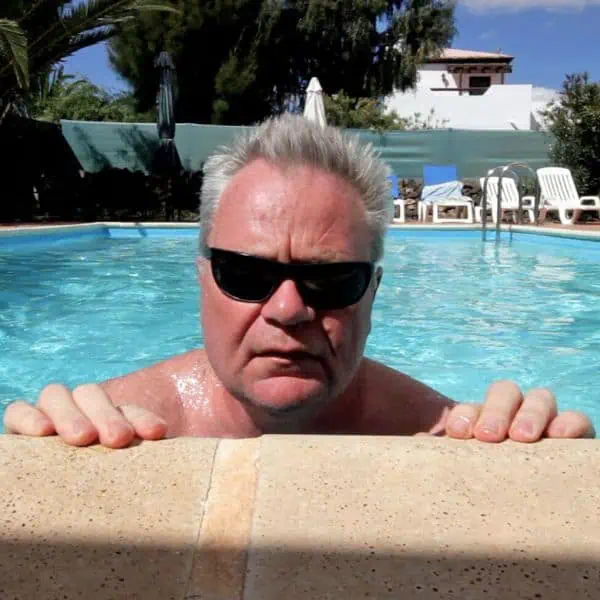Did you know a small mistake in shocking your pool could burn a hole in your wallet? Yep, I couldn’t believe it either.
A sparkling, clean pool is a dream, but it comes with its challenges. At first glance, the process of shocking your pool doesn’t seem complicated. But missing a crucial step could lead to disastrous and costly mistakes.
Imagine the relief you’ll feel once you know how to avoid these blunders. Trust me; you’ll want to stick around for this one because the secrets we’re about to dive into are game-changing.
Ready to save your pool and your budget? Let’s look at the 5 pool shock mistakes so you can avild them.

Using the Wrong Amount of Shock
Measuring pool shock might seem easy, but it’s crucial to get it just right.
- Too little, and your pool’s water could turn into a breeding ground for algae and bacteria.
- Too much, and you risk damaging your pool equipment and making the water unsafe to swim in.
Think of it like seasoning your favorite dish; a pinch too little or too much can throw everything off.
Always check the guidelines on the package you’re using. It’s like following a recipe—consistency is key for ideal results.
Most manufacturers provide a chart that links the pool size to the amount of shock needed. Don’t eyeball it. Grab a pool shock calculator or an app—yes, they exist! This will help you calculate the precise amount based on your pool’s volume. Pool Volume Calculator
So, before transforming your backyard into a toxic lagoon, remember: measure twice, pour once. Your swimming pool can be an inviting oasis or a financial headache, and often, it’s the little things like the correct amount of pool shock that make all the difference.
Timing Your Pool Shock Incorrectly
Timing really is everything when it comes to pool maintenance. Shock your pool during the wrong time of day, and your efforts can literally evaporate. Sunlight breaks down chlorine, which means shocking your pool while the sun is out in full force is not the best strategy.
The sweet spot is at dusk or nighttime. When the sun dips below the horizon, your chlorine has a fighting chance to work its magic overnight, undisturbed by UV rays. Plus, you won’t be competing with the daily swimmers for the perfect moment to carry out this task.
Shocking at night, ensuring the pump runs overnight too, also allows you to wake up to a fresher, cleaner pool. Isn’t there something satisfying about starting your day with glistening water awaiting you?
Pay attention to your pool’s mood and schedule its spa treatment accordingly. You’ll thank yourself when your pool stays perfect throughout the hottest days.
Read: When to shock your pool
Mixing Shock with Other Chemicals
Ever mixed two cleaning products and regretted it? Trust me, that’s a lesson you don’t want to learn in your pool. Combining pool shock with other chemicals can lead to dangerous reactions. Imagine playing mixologist and accidentally stirring up trouble—literally.
The good rule to live by? Patience is paramount. Always add chemicals separately, giving each one time to work its magic. Think of it like a stage performance, where each performer needs their spotlight time to shine. You wouldn’t want everyone on stage at once; the same goes for your pool.
Whether it’s algaecides, pH adjusters, or any other agents, bring them in one at a time. That way, you maintain control over your pool’s chemistry, reducing the risk of unintentional reactions that could cloud your water or worse. Revel in the peace of mind that each chemical has done its job before moving on to the next.
Ignoring Water Balance Before Shocking
Imagine baking a cake without checking your ingredients first. That’s what it’s like shocking a pool without balancing the water first! The balance of pH, alkalinity, and calcium hardness serves as the foundation for your shock treatment to be effective.
Test your water’s pH levels, aim for somewhere between 7.2 and 7.6 for optimal results. A balanced pH ensures your shock doesn’t prematurely dissipate, leaving your water wanting more. It’s the difference between your swimming pool looking like a lagoon or like a tropical paradise.
Read: How to test pool water
The proper water levels help protect your pool equipment and enhance swimmer comfort. Invest in a reliable water testing kit, and make it your best friend. By starting with the right water conditions, you set the stage for every chemical action in your pool to succeed.
Overlooking Safety Precautions
This might sound like a no-brainer, but safety first! Handling pool shock is serious business. Whether you’ve been managing your pool for years or are just starting, safety precautions should never be skipped. You wouldn’t dance in the rain without a plan, right?
From goggles to gloves to ventilated spaces, each piece of protective gear has a job. Pool shock chemicals can irritate skin, eyes, and respiratory systems. Keep your pool shocking chore safe by suiting up as if you’re going into a backyard battle—because, in a way, you are.
Always make sure to store chemicals away from children and pets, in a cool and dry area. Ensure your home’s first aid kit is stocked with items for chemical irritation. Locksmith your way to a safer pool shock experience by making these safety steps habitual.





Leave a Reply